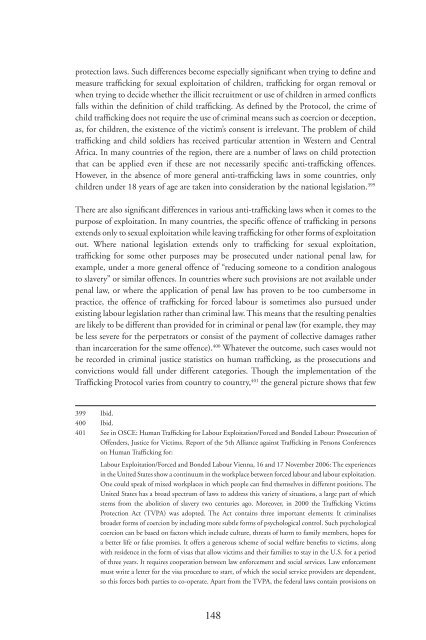Trafficking in human beings: human rights and ... - unesdoc - Unesco
Trafficking in human beings: human rights and ... - unesdoc - Unesco
Trafficking in human beings: human rights and ... - unesdoc - Unesco
Create successful ePaper yourself
Turn your PDF publications into a flip-book with our unique Google optimized e-Paper software.
protection laws. Such differences become especially signifi cant when try<strong>in</strong>g to defi ne <strong>and</strong><br />
measure traffi ck<strong>in</strong>g for sexual exploitation of children, traffi ck<strong>in</strong>g for organ removal or<br />
when try<strong>in</strong>g to decide whether the illicit recruitment or use of children <strong>in</strong> armed confl icts<br />
falls with<strong>in</strong> the defi nition of child traffi ck<strong>in</strong>g. As defi ned by the Protocol, the crime of<br />
child traffi ck<strong>in</strong>g does not require the use of crim<strong>in</strong>al means such as coercion or deception,<br />
as, for children, the existence of the victim’s consent is irrelevant. The problem of child<br />
traffi ck<strong>in</strong>g <strong>and</strong> child soldiers has received particular attention <strong>in</strong> Western <strong>and</strong> Central<br />
Africa. In many countries of the region, there are a number of laws on child protection<br />
that can be applied even if these are not necessarily specifi c anti-traffi ck<strong>in</strong>g offences.<br />
However, <strong>in</strong> the absence of more general anti-traffi ck<strong>in</strong>g laws <strong>in</strong> some countries, only<br />
children under 18 years of age are taken <strong>in</strong>to consideration by the national legislation. 399<br />
There are also signifi cant differences <strong>in</strong> various anti-traffi ck<strong>in</strong>g laws when it comes to the<br />
purpose of exploitation. In many countries, the specifi c offence of traffi ck<strong>in</strong>g <strong>in</strong> persons<br />
extends only to sexual exploitation while leav<strong>in</strong>g traffi ck<strong>in</strong>g for other forms of exploitation<br />
out. Where national legislation extends only to traffi ck<strong>in</strong>g for sexual exploitation,<br />
traffi ck<strong>in</strong>g for some other purposes may be prosecuted under national penal law, for<br />
example, under a more general offence of “reduc<strong>in</strong>g someone to a condition analogous<br />
to slavery” or similar offences. In countries where such provisions are not available under<br />
penal law, or where the application of penal law has proven to be too cumbersome <strong>in</strong><br />
practice, the offence of traffi ck<strong>in</strong>g for forced labour is sometimes also pursued under<br />
exist<strong>in</strong>g labour legislation rather than crim<strong>in</strong>al law. This means that the result<strong>in</strong>g penalties<br />
are likely to be different than provided for <strong>in</strong> crim<strong>in</strong>al or penal law (for example, they may<br />
be less severe for the perpetrators or consist of the payment of collective damages rather<br />
than <strong>in</strong>carceration for the same offence). 400 Whatever the outcome, such cases would not<br />
be recorded <strong>in</strong> crim<strong>in</strong>al justice statistics on <strong>human</strong> traffi ck<strong>in</strong>g, as the prosecutions <strong>and</strong><br />
convictions would fall under different categories. Though the implementation of the<br />
Traffi ck<strong>in</strong>g Protocol varies from country to country, 401 the general picture shows that few<br />
399 Ibid.<br />
400 Ibid.<br />
401 See <strong>in</strong> OSCE: Human Traffi ck<strong>in</strong>g for Labour Exploitation/Forced <strong>and</strong> Bonded Labour: Prosecution of<br />
Offenders, Justice for Victims. Report of the 5th Alliance aga<strong>in</strong>st Traffi ck<strong>in</strong>g <strong>in</strong> Persons Conferences<br />
on Human Traffi ck<strong>in</strong>g for:<br />
Labour Exploitation/Forced <strong>and</strong> Bonded Labour Vienna, 16 <strong>and</strong> 17 November 2006: The experiences<br />
<strong>in</strong> the United States show a cont<strong>in</strong>uum <strong>in</strong> the workplace between forced labour <strong>and</strong> labour exploitation.<br />
One could speak of mixed workplaces <strong>in</strong> which people can fi nd themselves <strong>in</strong> different positions. The<br />
United States has a broad spectrum of laws to address this variety of situations, a large part of which<br />
stems from the abolition of slavery two centuries ago. Moreover, <strong>in</strong> 2000 the Traffi ck<strong>in</strong>g Victims<br />
Protection Act (TVPA) was adopted. The Act conta<strong>in</strong>s three important elements: It crim<strong>in</strong>alises<br />
broader forms of coercion by <strong>in</strong>clud<strong>in</strong>g more subtle forms of psychological control. Such psychological<br />
coercion can be based on factors which <strong>in</strong>clude culture, threats of harm to family members, hopes for<br />
a better life or false promises. It offers a generous scheme of social welfare benefi ts to victims, along<br />
with residence <strong>in</strong> the form of visas that allow victims <strong>and</strong> their families to stay <strong>in</strong> the U.S. for a period<br />
of three years. It requires cooperation between law enforcement <strong>and</strong> social services. Law enforcement<br />
must write a letter for the visa procedure to start, of which the social service providers are dependent,<br />
so this forces both parties to co-operate. Apart from the TVPA, the federal laws conta<strong>in</strong> provisions on<br />
148

















